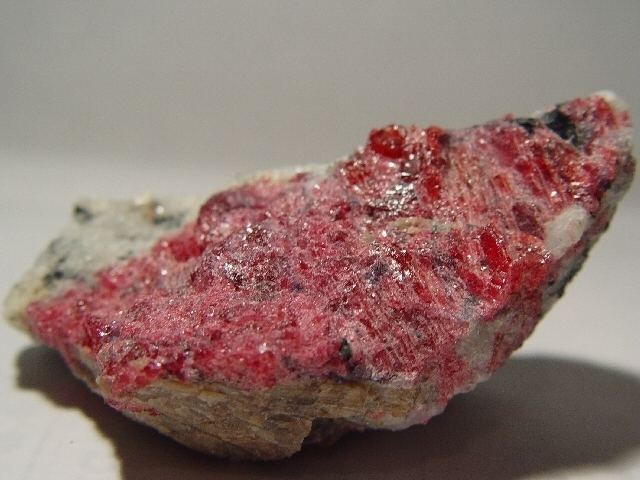Category Cyclosilicate Crystal system Trigonal | Strunz classification 9.CO.10 Space group R3m | |
 | ||
Formula(repeating unit) Na15Ca6(Fe,Mn)3Zr3SiO(O,OH,H2O)3(Si3O9)2(Si9O27)2(OH,Cl)2 Crystal class Hexagonal scalenohedral (3m)H-M symbol: (3 2/m) | ||
Eudialyte, whose name derives from the Greek phrase Εὖ διάλυτος eu dialytos, meaning "well decomposable", is a somewhat rare, nine member ring cyclosilicate mineral, which forms in alkaline igneous rocks, such as nepheline syenites. Its name alludes to its ready solubility in acid.
Contents
Eudialyte was first described in 1819 for an occurrence in nepheline syenite of the Ilimaussaq intrusive complex of southwest Greenland.
Uses of eudialyte
Eudialyte is used as a minor ore of zirconium. Another use of eudialyte is as a minor gemstone, but this use is limited by its rarity, which is compounded by its poor crystal habit. These factors make eudialyte of primary interest as a collector's mineral. Eudialyte typically has a significant content of U, Pb, Nb, Ta, Zr, Hf, and rare earth elements (REE). Because of this, it is very common geoscientists use eudialyte as a geochronometer to date and investigate the genesis of the host rocks.
Associated minerals
Eudialyte is found associated with other alkalic igneous minerals, in addition to the some minerals common to most igneous material in general.
Associate minerals include: microcline, nepheline, aegirine, lamprophyllite, lorenzenite, catapleiite, murmanite, arfvedsonite, sodalite, aenigmatite, rinkite, låvenite, titanite and titanian magnetite.
Alternative names
Alternative names of eudialyte include: almandine spar, eudalite, Saami blood. Eucolite is the name of an optically negative variety, more accurately the group member: ferrokentbrooksite.
Eudialyte group
Microchemical (by electron microprobe) and structural analyses of different eudialyte (and related) samples have revealed the presence of many new eudialyte-like minerals. These minerals are structurally and chemically related and joined into the eudialyte group. The group includes Zr-, OH-, Cl-, F-, CO3- and possibly also SO4-bearing silicates of Na, K, H3O, Ca, Sr, REEs, Mn, Fe, Nb and W. Electron vacancies can be present in their structure, too.
